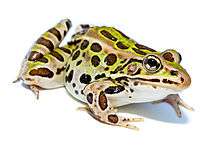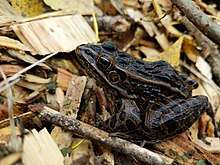Northern leopard frog
The northern leopard frog (Lithobates pipiens[1][2][3][4] or Rana pipiens[5][6]) is a species of leopard frog from the true frog family, native to parts of Canada and the United States. It is the state amphibian of Minnesota and Vermont.
| Northern leopard frog | |
|---|---|
 | |
| Scientific classification | |
| Kingdom: | Animalia |
| Phylum: | Chordata |
| Class: | Amphibia |
| Order: | Anura |
| Family: | Ranidae |
| Genus: | Lithobates |
| Species: | L. pipiens |
| Binomial name | |
| Lithobates pipiens (Schreber, 1782) | |
Description
The northern leopard frog is a fairly large species of frog, reaching about 11 cm (4.3 in) in snout-to-vent length. It varies from green to brown in dorsal color, with large, dark, circular spots on its back, sides, and legs.[7] Each spot is normally bordered by a lighter ring. A pair of dorsolateral folds starting from the back of the eye runs parallel to each other down the back. These dorsolateral folds are often lighter or occasionally pinkish in colour. Also, a pale stripe runs from the nostril, under the eye and tympanum, terminating at the shoulder. The ventral surface is white or pale green. The iris is golden and toes are webbed.
Tadpoles are dark brown or grey, with light blotches on the underside. The tail is pale tan.
Color variations

The northern leopard frog has several different color variations, with the most common two being the green and the brown morphs, with another morph known as the burnsi morph. Individuals with the burnsi morph coloration lack spots on their backs, but may or may not retain them on their legs. They can be bright green or brown and have yellow dorsal folds.[8] Albinism also appears in this species, but is very rare.
Ecology and behavior
Northern leopard frogs have a wide range of habitats. They are found in permanent ponds, swamps, marshes, and slow-moving streams throughout forest, open, and urban areas.[9] They normally inhabit water bodies with abundant aquatic vegetation. In the summer, they often abandon ponds and move to grassy areas and lawns. They are well adapted to cold and can be found above 3,000 m (9,800 ft) above mean sea level. Males make a short, snore-like call from water during spring and summer. The northern leopard frog breeds in the spring (March–June). Up to 6500 eggs are laid in water, and tadpoles complete development within the breeding pond. Tadpoles are light brown with black spots, and development takes 70–110 days, depending on conditions. Metamorph frogs are 2–3 cm (0.79–1.18 in) long and resemble the adult.
This species was once quite common through parts of western Canada and the United States until declines started occurring during the 1970s. Although the definitive cause of this decline is unknown, habitat loss and fragmentation, environmental contaminants, introduced fish, drought, and disease have been proposed as mechanisms of decline and are likely preventing species' recovery in many areas.[7] Many populations of northern leopard frogs have not yet recovered from these declines.
Northern leopard frogs are preyed upon by many different animals, such as snakes, raccoons, other frogs, and even humans. They do not produce distasteful skin secretions and rely on speed to evade predation.
They eat a wide variety of animals, including crickets, flies, worms, and smaller frogs. Using their large mouths, they can even swallow birds and garter snakes. In one case, a bat was recorded as prey of this frog.[10] This species is similar to the pickerel frog (Lithobates palustris) and the southern leopard frog (Lithobates sphenocephalus).
Research
Medical
The northern leopard frog produces specific ribonucleases to its oocytes. Those enzymes are potential drugs for cancer. One such molecule, called ranpirnase (onconase), is in clinical trials as a treatment for pleural mesothelioma and lung tumors. Another, amphinase, has been described as a potential treatment for brain tumors.[11]
Neuroscience
The northern leopard frog has been a preferred species for making discoveries about basic properties of neurons since the 1950s. The neuromuscular junction of the sciatic nerve fibers of the sartorius muscle of this frog has been the source of initial data about the nervous system.[12][13][14][15][16][17][18]
Muscle physiology and biomechanics
The northern leopard frog is a popular species for in vitro experiments in muscle physiology and biomechanics due to the ease of accessibility for investigators in its native range and the ability of the sartorius muscle to stay alive in vitro for several hours. Furthermore, the reliance of the frog on two major modes of locomotion (jumping and swimming) allows for understanding how muscle properties contribute to organismal performance in each of these modes.
As pets
Northern leopard frogs do well as a beginner pet. A standard 10-gallon tank is sufficient for a single northern leopard frog. A dense piece of wood can be placed partly in the water and land to provide easier transition from water and land (this also provides a basking spot). The substrate must be a combination of peat and moss, covered with orchid bark, and sphagnum moss can be used on the terrestrial side. The depth should be at least 2-3 inches to allow burrowing. Gravel can be used on the aquatic side. It is extremely important to use smooth gravel only (to prevent skin abrasions and injuries). Northern leopard frogs live in an area with 68 to 75 °F, although a temperature drop at night is beneficial (down to about 60 °F 16 °C). A secure lid (preferably a mesh lid with ventilation) is also a must - most frogs are adept at escaping, given the chance. Northern leopard frogs are fed a diet of crickets, mealworms, waxworms, or silkworms.
Range
Northern leopard frogs occur from Great Slave Lake and Hudson Bay, Canada, south to Kentucky and New Mexico, USA.[19][20] It is also found in Panama, where it is endemic to the central cordillera and western Pacific lowlands, although this is most likely an undescribed species.[1] They occupy grasslands, lakeshores, and marshes.
See also
| Wikispecies has information related to Lithobates pipiens |
| Wikimedia Commons has media related to Lithobates pipiens. |
References
- Hammerson, G.; Solís, F.; Ibáñez, R.; Jaramillo, C.; Fuenmayor, Q. (2004). "Lithobates pipiens". IUCN Red List of Threatened Species. 2004: e.T58695A11814172. doi:10.2305/IUCN.UK.2004.RLTS.T58695A11814172.en.
- Frost, Darrel (2011). "American Museum of Natural History: Amphibian Species of the World 5.5, an Online Reference". Herpetology. The American Museum of Natural History. Retrieved 2013-02-17.
- Frost, D.-R.; et al. (2009). "Response to the Point Of View of Gregory B. Pauly, David M. Hillis, and David C. Cannatella, by the Anuran Subcommittee of the SSRA/HL/ASIH Scientific and Standard English Names List". Herpetologica. 65 (2): 136–153. doi:10.1655/09-009R1.1.
- Integrated Taxonomic Information System [Internet] 2012. Lithobates pipiens [updated 2012 Sept; cited 2012 Dec 26] Available from: www.itis.gov/
- Hillis & Wilcox (2005), Hillis (2007), Stuart (2008), Pauly et al. (2009), AmphibiaWeb (2016)
- Yuan, Z.-Y.; et al. (2016). "Spatiotemporal diversification of the true frogs (genus Rana): A historical framework for a widely studied group of model organisms". Systematic Biology. 65 (5): 824–42. doi:10.1093/sysbio/syw055. PMID 27288482.
- Northern Leopard Frog Rana pipiens, National Geographic. Retrieved 2015-03-28
- "Northern Leopard Frog Rana pipens". HerpNet. Retrieved 2013-10-30.
- Northern Leopard Frog (Lithobates pipiens), Nevada Fish and Wildlife Office. Retrieved 2015-03-28.
- Mikula, P (2015). "Fish and amphibians as bat predators". European Journal of Ecology. 1 (1): 71–80. doi:10.1515/eje-2015-0010.
- Frog molecule could provide drug treatment for brain tumors
- Fatt, P; Katz, B (1952). "Spontaneous subthreshold activity at motor nerve endings". The Journal of Physiology. 117 (1): 109–28. doi:10.1113/jphysiol.1952.sp004735 (inactive 2020-03-25). PMC 1392564. PMID 14946732.
- Del Castillo, J; Katz, B (1954). "Quantal components of the end-plate potential". The Journal of Physiology. 124 (3): 560–73. doi:10.1113/jphysiol.1954.sp005129. PMC 1366292. PMID 13175199.
- Lettvin, J.Y.; Maturana, H.R.; McCulloch, W.S.; Pitts, W.H. (1959). "What the Frog's Eye Tells the Frog's Brain". Proceedings of the IRE. 47 (11): 1940–51. doi:10.1109/JRPROC.1959.287207.
- Katz, B; Miledi, R (1965). "The Measurement of Synaptic Delay, and the Time Course of Acetylcholine Release at the Neuromuscular Junction". Proceedings of the Royal Society of London. Series B. 161 (985): 483–95. doi:10.1098/rspb.1965.0016. PMID 14278409.
- Kuffler, SW; Yoshikami, D (1975). "The number of transmitter molecules in a quantum: An estimate from iontophoretic application of acetylcholine at the neuromuscular synapse". The Journal of Physiology. 251 (2): 465–82. doi:10.1113/jphysiol.1975.sp011103. PMC 1348438. PMID 171380.
- Hille, B (1967). "The selective inhibition of delayed potassium currents in nerve by tetraethylammonium ion". The Journal of General Physiology. 50 (5): 1287–302. doi:10.1085/jgp.50.5.1287. PMC 2225709. PMID 6033586.
- Anderson, CR; Stevens, CF (1973). "Voltage clamp analysis of acetylcholine produced end-plate current fluctuations at frog neuromuscular junction". The Journal of Physiology. 235 (3): 655–91. doi:10.1113/jphysiol.1973.sp010410. PMC 1350786. PMID 4543940.
- Stebbins, R.C. (1985). A Field Guide to Western Reptiles and Amphibians. Second Edition. Houghton Mifflin Company, Boston, Massachusetts.
- Conant, R. and Collins, J.T. (1991). A Field Guide to Reptiles and Amphibians: Eastern and Central North America. Third Edition. Houghton Mifflin Company, Boston, Massachusetts.
Further reading
- AmphibiaWeb, available at http://amphibiaweb.org/
- Ankley GT, Tietge JE, DeFoe DL, Jensen KM, Holcombe GW, Durhan EJ, Diamond SA. (1998). "Effects of ultraviolet light and methoprene on survival and development of Rana pipiens ". Environmental Toxicology and Chemistry 17 (12): 2530-2542. (abstract)*Hillis DM (1988). "Systematics of the Rana pipiens Complex: Puzzle and Paradigm". Annual Review of Ecology and Systematics. 19: 39–63. doi:10.1146/annurev.es.19.110188.000351. JSTOR 2097147.
- Hillis, D. M. (2007). "Constraints in naming parts of the Tree of Life" (PDF). Mol. Phylogenet. Evol. 42: 331–338. doi:10.1016/j.ympev.2006.08.001. PMID 16997582.
- Hillis, David M.; Frost, John S.; Wright, David A. (1983). "Phylogeny and Biogeography of the Rana pipiens Complex: A Biochemical Evaluation". Systematic Zoology. 32 (2): 132–43. doi:10.1093/sysbio/32.2.132. JSTOR 2413277.
- Hillis, D. M.; Wilcox, T. P. (2005). "Phylogeny of the New World true frogs (Rana)". Mol. Phylogenet. Evol. 34 (2): 299–314. doi:10.1016/j.ympev.2004.10.007. PMID 15619443.
- Pauly, Greg B.; Hillis, David M.; Cannatella, David C. (2009). "Taxonomic freedom and the role of official lists of species names" (PDF). Herpetologica. 65 (2): 115–128. doi:10.1655/08-031r1.1. Archived from the original (PDF) on 2011-07-26.
- Schreber JCD von. (1782). "Beytrag zur Naturgeschichte der Frösche ". Der Naturforscher, Halle 18: 182-193. (Rana pipiens, new species). (in German).
- Stuart, Bryan L (2008). "The phylogenetic problem of Huia (Amphibia: Ranidae)". Mol. Phylogenet. Evol. 46 (1): 49–60. doi:10.1016/j.ympev.2007.09.016. PMID 18042407.
- Yuan, Z.-Y.; Zhou, W.-W.; Chen, X.; Poyarkov, N. A.; Chen, H.-M.; Jang-Liaw, N.-H.; Chou, W.-H.; Iizuka, K.; Min, M.-S.; Kuzmin, S. L.; Zhang, Y.-P.; Cannatella, D. C.; Hillis, D. M.; Che, J. (2016). "Spatiotemporal diversification of the true frogs (genus Rana): A historical framework for a widely studied group of model organisms". Systematic Biology. 65 (5): 824–42. doi:10.1093/sysbio/syw055. PMID 27288482.
External links
- Northern Leopard Frog (Rana pipiens) — Natural Resources Canada.
- AWD: Rana pipiens — animal diversity, University of Michigan.
- BBC news: "Rana pipiens and the treatment of brain tumours."
